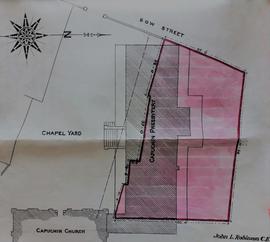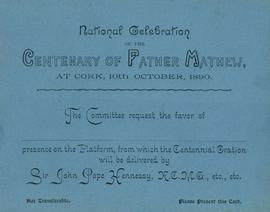Research relating to Father Mathew
- IE CA FM RES/4/1/2
- File
- c.1832-1845
Part of Irish Capuchin Archives
• Letter from Patrick Forrestal to Fr. Aloysius Travers OFM Cap. giving his father’s recollections of Fr. Mathew. He writes ‘My father was born in 1832 in the Parish of Ramsgrange, Wexford. … . He took the pledge from Father Mathew and kept it about 16 years. … It was very remarkable the multitude that gathered around him, the platform was enormous, something like ten thousand. He [Fr. Mathew] walked off the platform to where my father stood and told him you are very young may God bless you and placed his two hands around his head …’. [c.1902]. Manuscript, 6 pp.
• Copy article from the 'Cork Examiner' on Fr. Mathew’s birthplace. 27 Oct. 1931. Typescript, 1 p.
• Note by Fr. Francis Hayes OFM Cap. re two contemporary engravings of Fr. Mathew in the possession of Charlie McCarthy. Fr. Francis notes that they were engraved and designed by John Brown, Patrick Street, Cork, heraldic artist for Fr. Theobald Mathew OSFC, 1845. Typescript, 1 p.
• Note on the inscription on the Daniel O’Connell memorial window in Holy Trinity (Father Mathew Memorial) Church in Cork. It reads: ‘Sacred in gratitude and affection to the memory of Daniel O’Connell, liberator of his fellow Catholics from the inflictions of the Penal Code and assertion of equal rights of all communities to civil and religious freedom, RIP’. Manuscript, 1 p.
• Cuttings referring to the visit of Fr. Mathew to Kilkenny where he had ‘17,000 adherents to the total abstinence principles’ and a similar visit to Limerick. 'Morning Register', 23 Jan. 1840; 'Saunder’s News-Letter', 23 Mar. 1840. Pasted onto card, 2 pp.
• Copy excerpts from the 'Quarterly Review', December 1840-Mar. 1841, referring (negatively) to the relationship between the Fr. Mathew’s temperance movement and ‘Romanism in Ireland’. Typescript, 1 p.
• Notes by Fr. Paul Neary OSFC re Fr. Mathew taken from 'The Nation'. Manuscript, 10 pp.
• Letter from Deborah Webb to Fr. Silvester Mulligan OSFC enclosing her recollections of a meeting with Fr. Theobald Mathew OSFC in Rathfarnham, Dublin. 25 Oct. 1913. Manuscript, 5 pp.
• Extracts relating to Fr. Theobald Mathew OSFC in the Life of Catherine MacAuley. Typescript, 1 p.
• Extracts from 'Tuckey’s Cork Remembrances' (Cork, 1838), John D’Alton, 'History of the County of Dublin' (Dublin, 1838), 'The Irish Magazine', and 'Dublin University Magazine' re the Capuchins in Cork and Fr. Theobald Mathew OSFC. One of the extract reads ‘10 Oct. 1810: The corporation determined to improve this city, by pulling down the houses on the right of Blackamoor Lane, and continuing Sullivan’s Quay to the South Bridge’. Manuscript, 8 pp.
• Extract from An Irishman’s diary by Quidnunc in the 'Irish Times', 9 Aug. 1943, referring to visit to London by Fr. Mathew in Aug. 1843. ‘Led off by prayer and a speech, the temperance pioneer received pledges from 3,000 abstainers during one day, of which number about one-half were Irish’. Typescript, 1 p.



